Deep in the lush rainforests of Southeast Asia lives a remarkable reptile with an extraordinarily confined lifestyle. Unlike most snakes that traverse vast territories in search of prey and mates, the paradise flying snake (Chrysopelea paradisi) may spend its entire existence within the branches of a single tree. This specialized arboreal lifestyle represents one of nature’s most fascinating examples of habitat specialization. The snake’s unique adaptations for tree-dwelling and its remarkable gliding abilities have made it a subject of scientific intrigue and wonder. Through a combination of specialized scales, physical adaptations, and behavioral traits, these serpents have mastered life in the canopy, rarely if ever needing to descend to the forest floor below.
The Ultimate Tree-Dweller: An Evolutionary Marvel
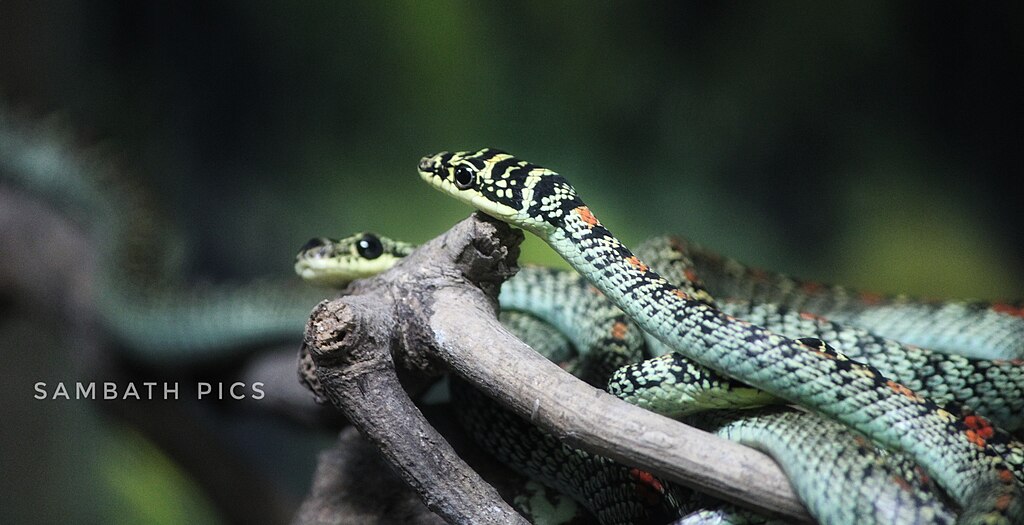
Paradise flying snakes represent the pinnacle of arboreal specialization in the snake world. Their evolutionary journey has transformed them into creatures perfectly suited for life among the branches. With slender bodies rarely exceeding three feet in length, these snakes possess specialized scales that create a concave surface on their underside when they flatten their bodies. This adaptation not only helps them grip tree bark efficiently but also plays a crucial role in their gliding capabilities. Their tree-dwelling lifestyle has been refined over millions of years, resulting in a reptile that finds everything it needs—from food to shelter to mates—within the confines of a single tree’s ecosystem. Unlike most reptiles that require diverse habitats throughout their lifecycle, these remarkable snakes have evolved to thrive within an extremely limited geographical range.
Anatomy Designed for Arboreal Life
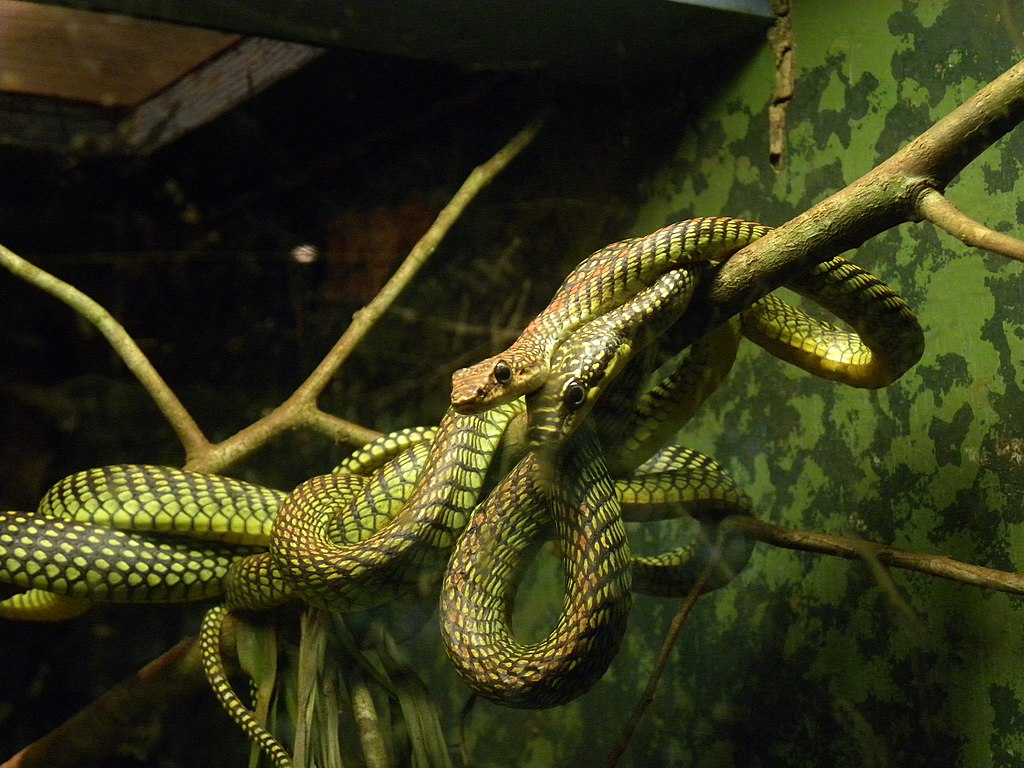
Every aspect of the paradise flying snake’s physical design reflects its commitment to canopy living. Their bodies are remarkably slender and lightweight, optimized for moving across thin branches without causing them to bend dangerously. The snake’s keeled scales provide exceptional grip on bark and leaves, allowing it to navigate vertical surfaces with ease. Perhaps most distinctive is their coloration—a vivid pattern of black, green, and yellow that provides perfect camouflage among the dappled light of the forest canopy. Their heads are slightly flattened and their eyes are proportionally large with round pupils, providing excellent vision for hunting in the three-dimensional environment of the treetops. These anatomical specializations collectively create a reptile that feels awkward and vulnerable on the ground but moves with remarkable grace and precision among the branches.
The Remarkable Flying Adaptation
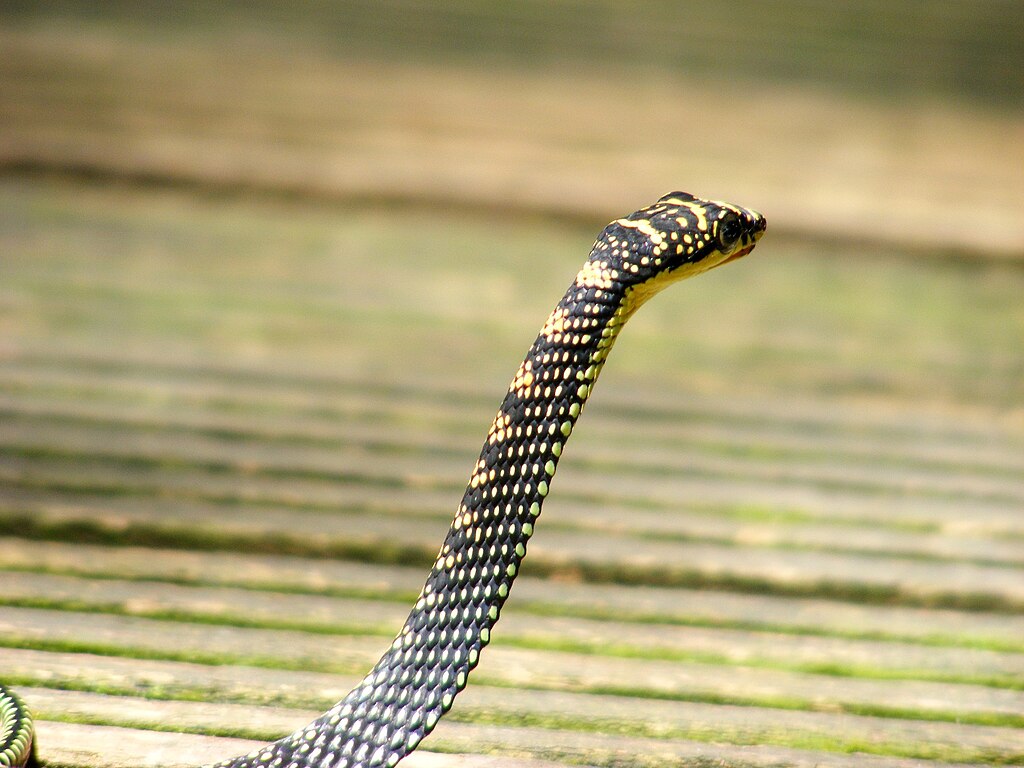
Despite their name, paradise flying snakes don’t truly fly but instead perform a controlled glide that represents one of nature’s most impressive locomotive adaptations. When preparing to launch from one tree to another, the snake dangles from a branch, forms a J-shape with its body, and then propels itself outward with a powerful push. Once airborne, it flattens its entire body by spreading its ribs and pulling in its ventral surface, effectively transforming its cylindrical form into a crude wing. Most remarkably, these snakes perform undulating S-shaped movements in mid-air that generate lift and allow them to control their trajectory with surprising precision. This extraordinary ability to glide up to 100 feet horizontally allows them to travel between feeding areas within their home tree or, when necessary, to colonize new trees without ever touching the dangerous forest floor.
Feeding Strategies in the Canopy
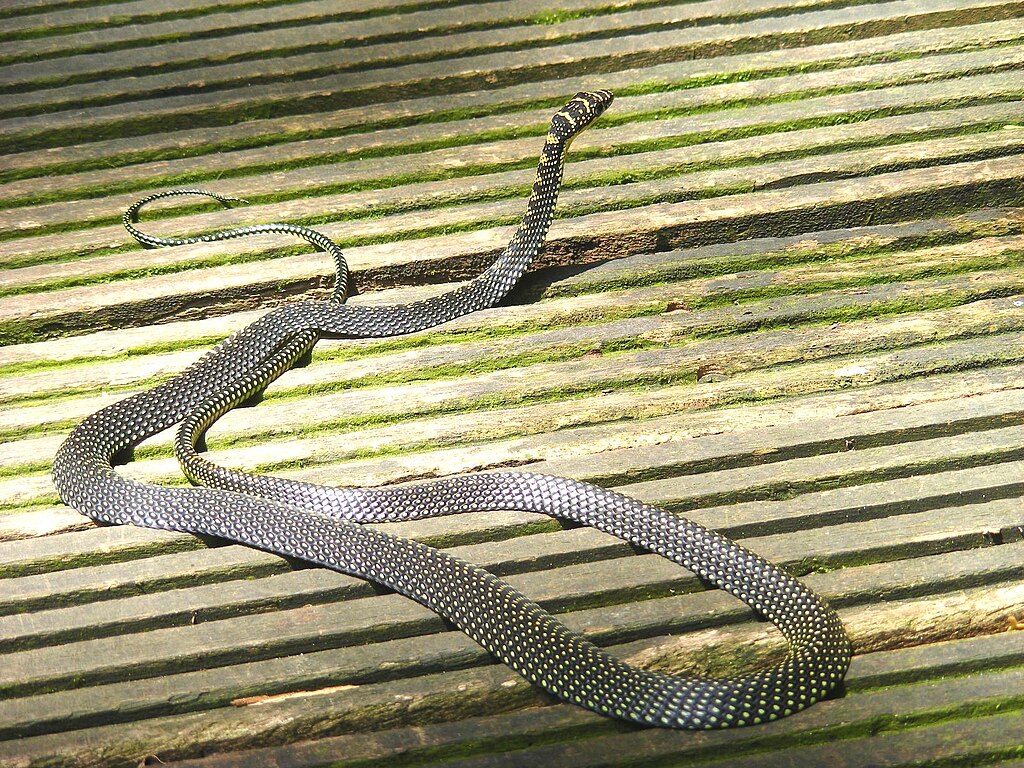
The paradise flying snake has developed hunting strategies perfectly suited to its arboreal lifestyle. These diurnal predators primarily target small lizards, particularly geckos and skinks that share their treetop habitat. Their hunting technique involves a slow, methodical stalk followed by a lightning-fast strike, with their excellent vision allowing them to detect prey movement even through dense foliage. After capturing prey, they deploy a mild venom that, while not dangerous to humans, quickly subdues their small victims. The abundance of potential prey within a mature rainforest tree means that a single large specimen might provide all the nutritional resources needed throughout the snake’s lifetime. Unlike ground-dwelling snakes that might need to traverse considerable distances between feeding opportunities, the paradise flying snake enjoys a relatively stable food supply within its arboreal domain.
A Self-Contained Ecosystem: The Home Tree

The concept of a single tree functioning as a complete ecosystem might seem surprising, but mature rainforest trees represent incredibly diverse biological communities. A single large dipterocarp or fig tree might host hundreds of plant species, including epiphytes, vines, and parasitic plants, along with thousands of insect species, dozens of bird species, and numerous mammals and reptiles. For the paradise flying snake, this biodiversity creates a self-contained world with all the resources needed for survival. The tree’s structure provides diverse microhabitats, from sun-drenched upper branches to shaded, humid lower sections, allowing the snake to thermoregulate effectively throughout the day. During seasonal changes or in response to weather events, these snakes can simply move to different portions of the tree rather than undertaking dangerous journeys to new locations.
Reproduction Without Leaving Home

The paradise flying snake’s life cycle is remarkably adapted to remain entirely within its arboreal domain. Males locate females through pheromone trails, tracking potential mates throughout the complex branch network of their home tree. Unlike many reptile species that require specific ground conditions for egg-laying, female flying snakes deposit their clutches of 6-12 eggs in tree hollows, abandoned bird nests, or accumulated plant debris in branch junctions. These elevated nesting sites protect the eggs from many ground-dwelling predators and the consistent humidity of the rainforest canopy provides suitable incubation conditions. Young snakes emerge fully equipped with the instinctive knowledge to navigate branches and glide between them, requiring no parental care or instruction. This reproductive strategy eliminates any need for these specialized reptiles to venture to the forest floor at any life stage.
Threats and Predators in the Canopy
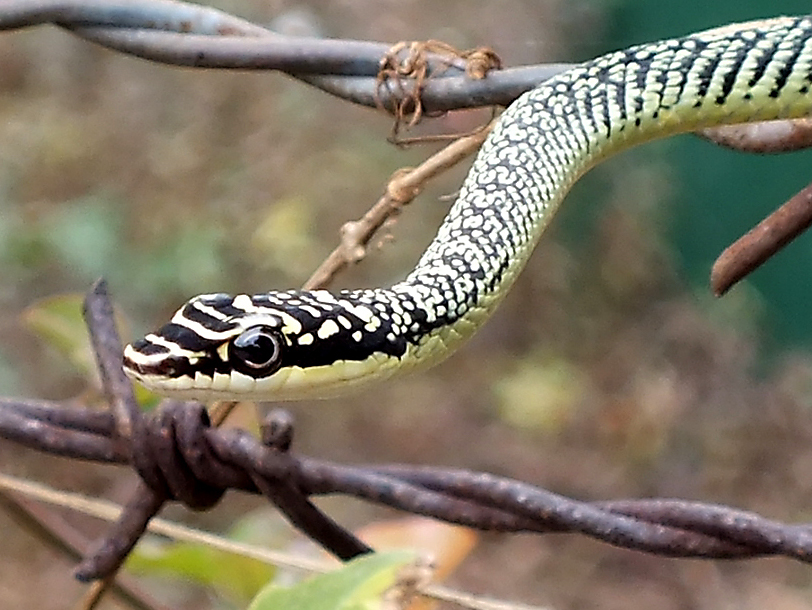
Despite their specialized adaptations, paradise flying snakes face numerous threats within their treetop realm. Birds of prey, particularly hawk eagles and serpent eagles, represent their primary predators, possessing the aerial agility to capture these snakes even during gliding attempts. Arboreal mammals, including some primates and palm civets, will opportunistically prey on these snakes when encountered. Perhaps surprisingly, other tree-dwelling snakes, particularly the larger species like emerald tree boas, may also hunt and consume flying snakes. Competition for resources within the limited space of a single tree can also pose challenges, especially during periods of resource scarcity. The paradise flying snake’s primary defense against these threats lies in its exceptional camouflage and ability to remain perfectly motionless among foliage, making it nearly invisible to predators passing overhead.
Environmental Challenges of Tree-Bound Living
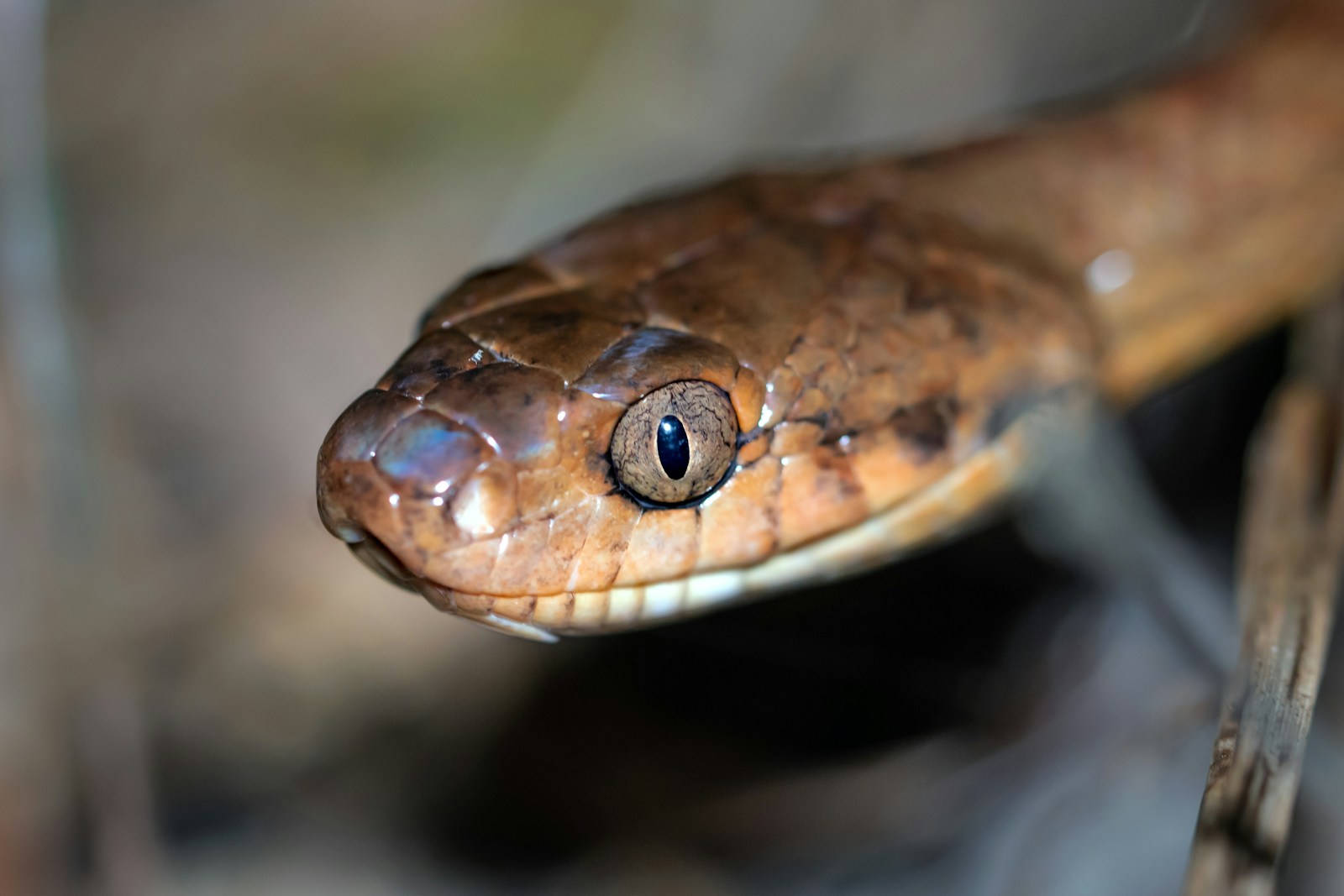
Restricting one’s entire existence to a single tree presents unique environmental challenges that the paradise flying snake has evolved to overcome. Temperature fluctuations within the canopy can be extreme, with upper branches experiencing intense heat during sunny days while lower portions remain cool. The snake manages these variations through careful thermoregulation, moving to sun-exposed branches in the morning and seeking shade during the hottest periods. Water acquisition represents another challenge, as these snakes rarely descend to drink from standing water. Instead, they have developed the ability to drink from water droplets that accumulate on leaves after rain or morning dew, using their scaled lips to efficiently gather moisture. During dry periods, they may extract adequate hydration from their prey, another adaptation that eliminates the need to leave their arboreal sanctuary.
Scientific Research and Discoveries

The paradise flying snake’s unique lifestyle has made it a subject of significant scientific interest, particularly regarding its gliding mechanics. Researchers at Virginia Tech have conducted extensive studies using high-speed cameras and 3D modeling to understand the aerodynamics involved in the snake’s aerial locomotion. Their findings revealed that the snake’s undulating motion in air creates unexpected vortices that actually generate lift, a mechanism previously unknown in animal flight. Behavioral studies have documented the extraordinary site fidelity of these snakes, with tagged individuals remaining within the same tree for years when undisturbed. Recent genetic research suggests that populations isolated in individual forest fragments may be developing distinctive traits, potentially leading to new subspecies formation. These scientific investigations continue to reveal the remarkable specializations that allow these reptiles to thrive within such a restricted habitat range.
Conservation Concerns and Habitat Loss
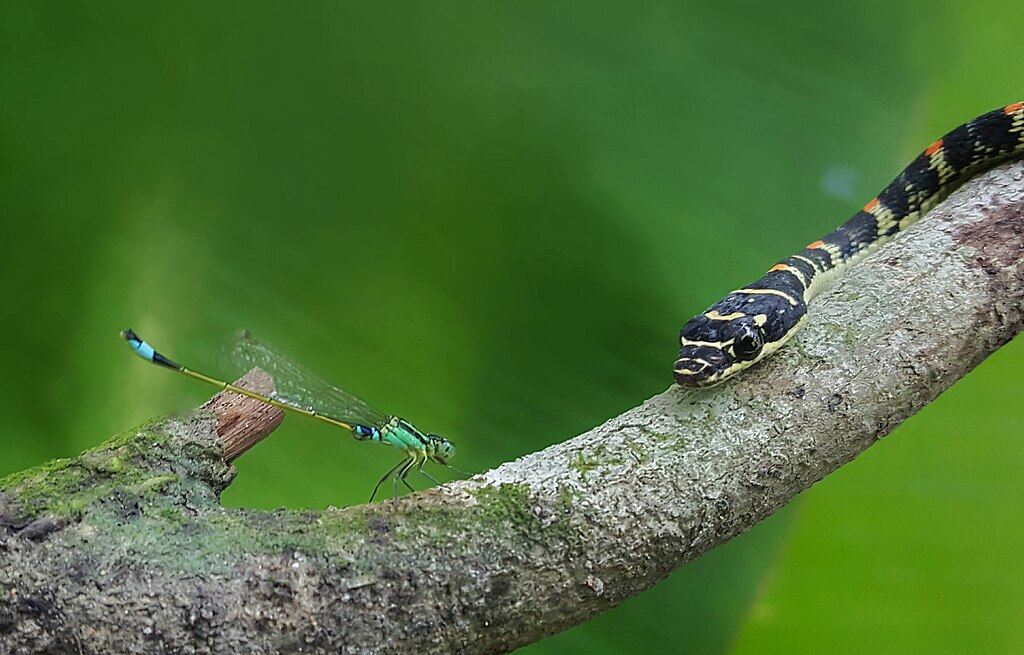
The highly specialized lifestyle of the paradise flying snake makes it particularly vulnerable to habitat disruption. Deforestation across Southeast Asia represents the single greatest threat to these remarkable reptiles. When their home tree is felled, these snakes face the nearly impossible task of traversing open ground to reach new forest habitat, exposing them to predators they have no evolutionary experience evading. The fragmentation of forests creates isolated tree “islands” too small to support viable populations, and the practice of selective logging often targets the largest, most mature trees that provide the most diverse microhabitats. Climate change poses additional threats, as altered rainfall patterns affect canopy humidity levels critical for successful reproduction. Conservation efforts focused on preserving intact forest corridors are essential for maintaining viable populations of these specialized reptiles.
Similar Tree-Dwelling Specialists
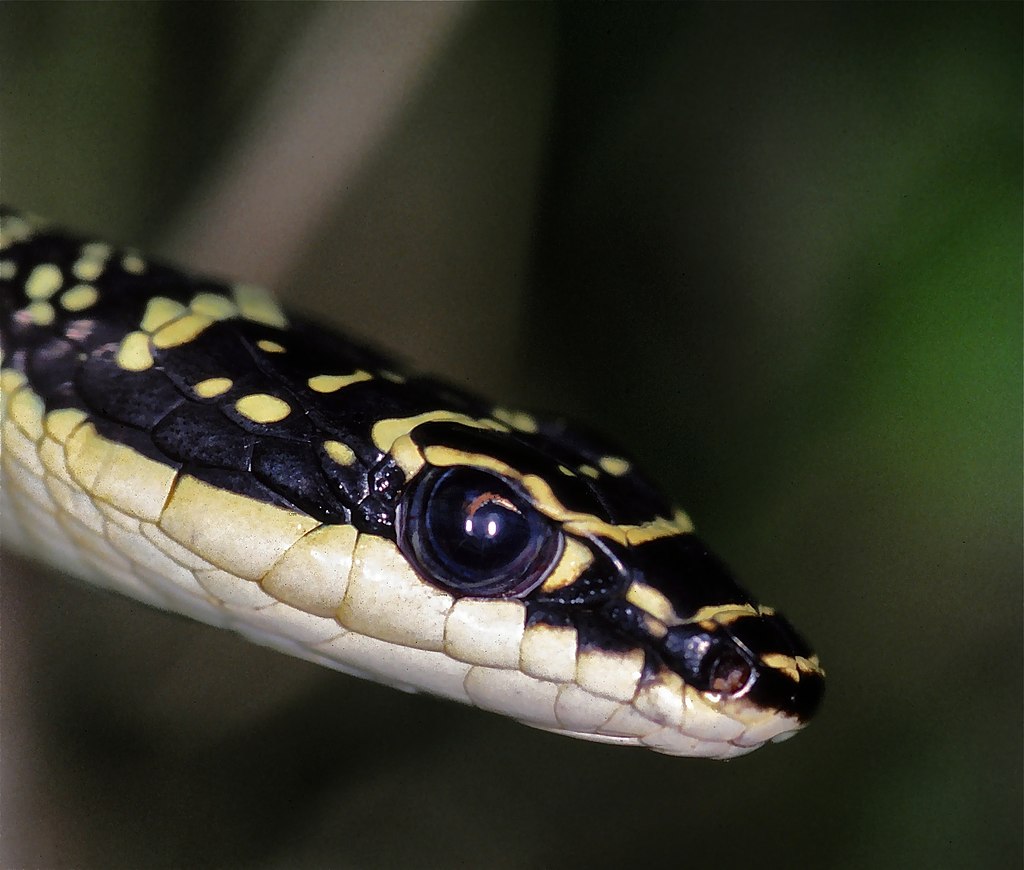
While the paradise flying snake represents an extreme example of arboreal specialization, other creatures have evolved similar tree-bound lifestyles. The pygmy three-toed sloth of Panama spends its entire life in red mangrove trees on a single island, having evolved a specialized diet and metabolism adapted to this limited environment. Certain species of poison dart frogs in Central America complete their entire life cycle within the water collected in bromeliad plants growing on a single host tree. The Brazilian pygmy owl has adapted to living exclusively in bamboo groves, hunting and nesting without ever leaving this specialized habitat. These evolutionary parallels demonstrate how diverse animal groups can independently develop extreme habitat specialization when ecological conditions favor such adaptations, resulting in creatures perfectly adapted to extremely limited geographical ranges.
Cultural Significance and Human Interactions
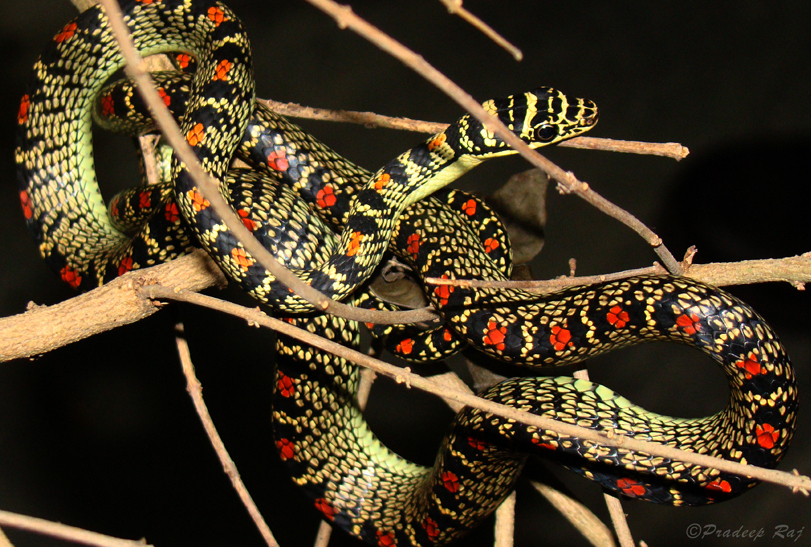
The paradise flying snake has secured a place in the cultural traditions of many indigenous communities throughout Southeast Asia. In parts of Malaysia and Indonesia, these serpents are considered beneficial creatures that protect trees from harmful pests, leading to local taboos against harming them. Their remarkable gliding ability has inspired numerous myths, including beliefs that they can fly between trees using invisible wings granted by forest spirits. Traditional medicinal practices in some regions utilize parts of these snakes for treatments related to respiratory ailments, though these practices have declined with conservation awareness. Today, the paradise flying snake occasionally appears in the international pet trade, though their specialized needs make them challenging to maintain in captivity, and ethical concerns about removing these habitat specialists from their natural environment persist among conservationists.
Lessons from Nature’s Ultimate Specialist

The paradise flying snake offers profound insights into evolutionary specialization and the delicate balance between adaptation and vulnerability. Its remarkable success within an extremely narrow ecological niche demonstrates nature’s capacity for producing highly specialized solutions to environmental challenges. However, this specialization comes with inherent risks—the more perfectly adapted an organism becomes to specific conditions, the more catastrophic change can be. For conservation biologists, these snakes represent a compelling case study in the importance of preserving intact ecosystems rather than focusing solely on individual species protection. For biomimicry researchers, their unique gliding mechanisms continue to inspire innovations in robotics and material science. Perhaps most importantly, these remarkable reptiles remind us that in nature, extraordinary specialization can be as successful a strategy as generalization—at least until environmental conditions change.
The paradise flying snake’s extraordinary lifestyle—confined to a single tree yet perfectly adapted to thrive within that limited domain—represents one of nature’s most elegant examples of specialized evolution. Through remarkable adaptations from its flattening body during glides to its ability to find all necessary resources within its arboreal home, this serpent has mastered a lifestyle few other vertebrates could sustain. As rainforests continue to face unprecedented threats, the fate of these single-tree specialists hangs in balance, their future dependent on our ability to preserve the complex ecosystems they inhabit. Their story serves as both inspiration and warning—a testament to evolution’s power to create perfect specialists and a reminder of the fragility such specialization can entail in a rapidly changing world.





